Breguet Classique 7787 Moonphase with Grand Feu Enamel Dial
"Classique" Breguet, in the best possible definition of this word.
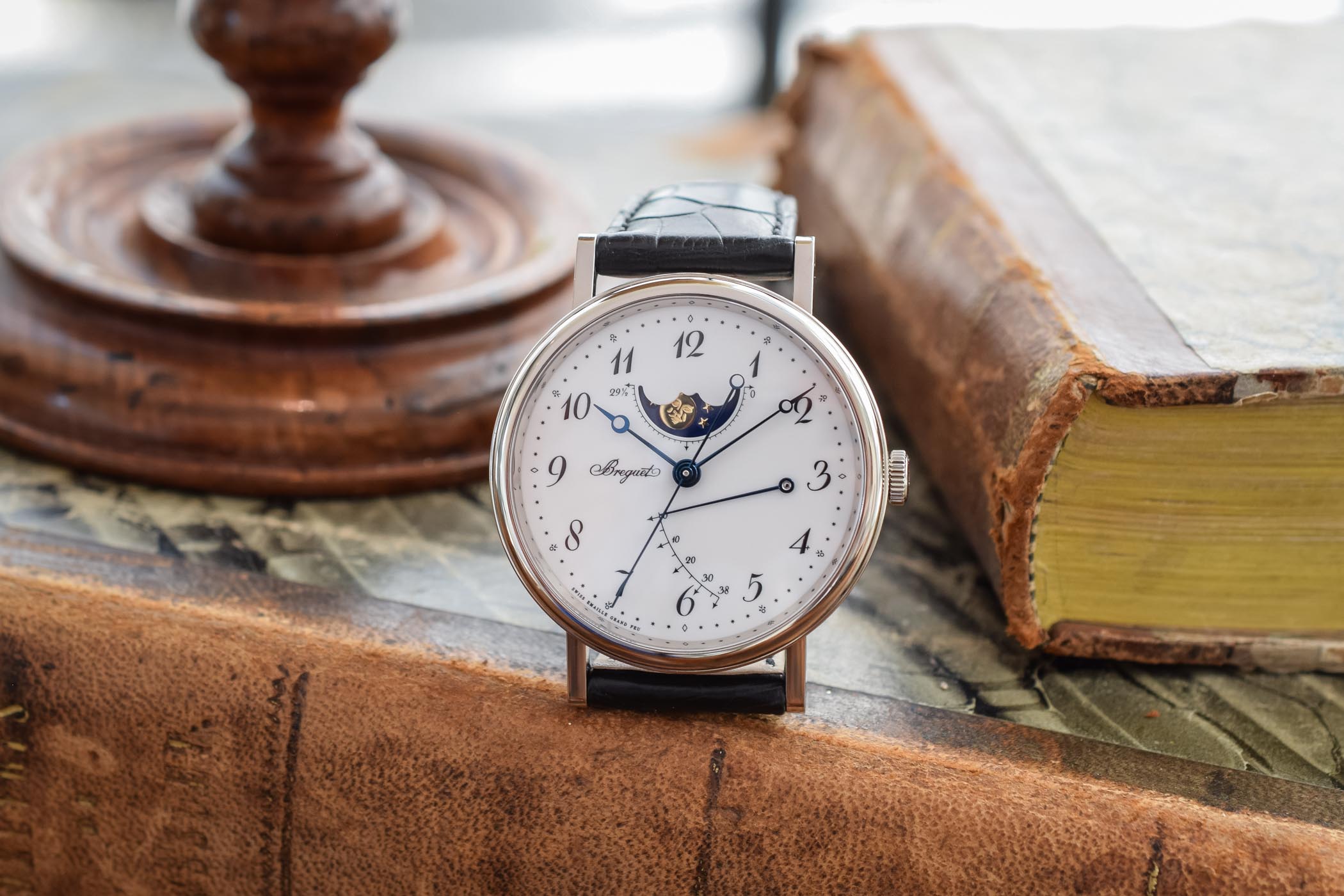
I’d love to say that I’d be curious to see what a modernly designed Breguet would look like… But I can’t! I can’t, simply because Breguet carries so much history and legacy that it must not be bolder than it should, or experiment with avant-garde design… It can be (and actually is) innovative technically speaking, but as far as I’m concerned, a Breguet watch should be a treaty of elegance and classicism. Fortunately, the manufacture is pretty good in keeping this alive. As a perfect example of this, we take a look at the superb Breguet Classique 7787 Moonphase with a Grand Feu enamel dial.
Inspired by an antique pocket watch, the Breguet N°5
It would be hard to label the team at Breguet as 2.0, X-generation creative geniuses. Things don’t work this way at Breguet, you can leave the bold and modern creativity to others. Things take time and need to be historically relevant respecting the name that is printed on the dial… And indeed, this suits the brand pretty well as you can see with this Breguet Classique 7787, a model inspired by the past.
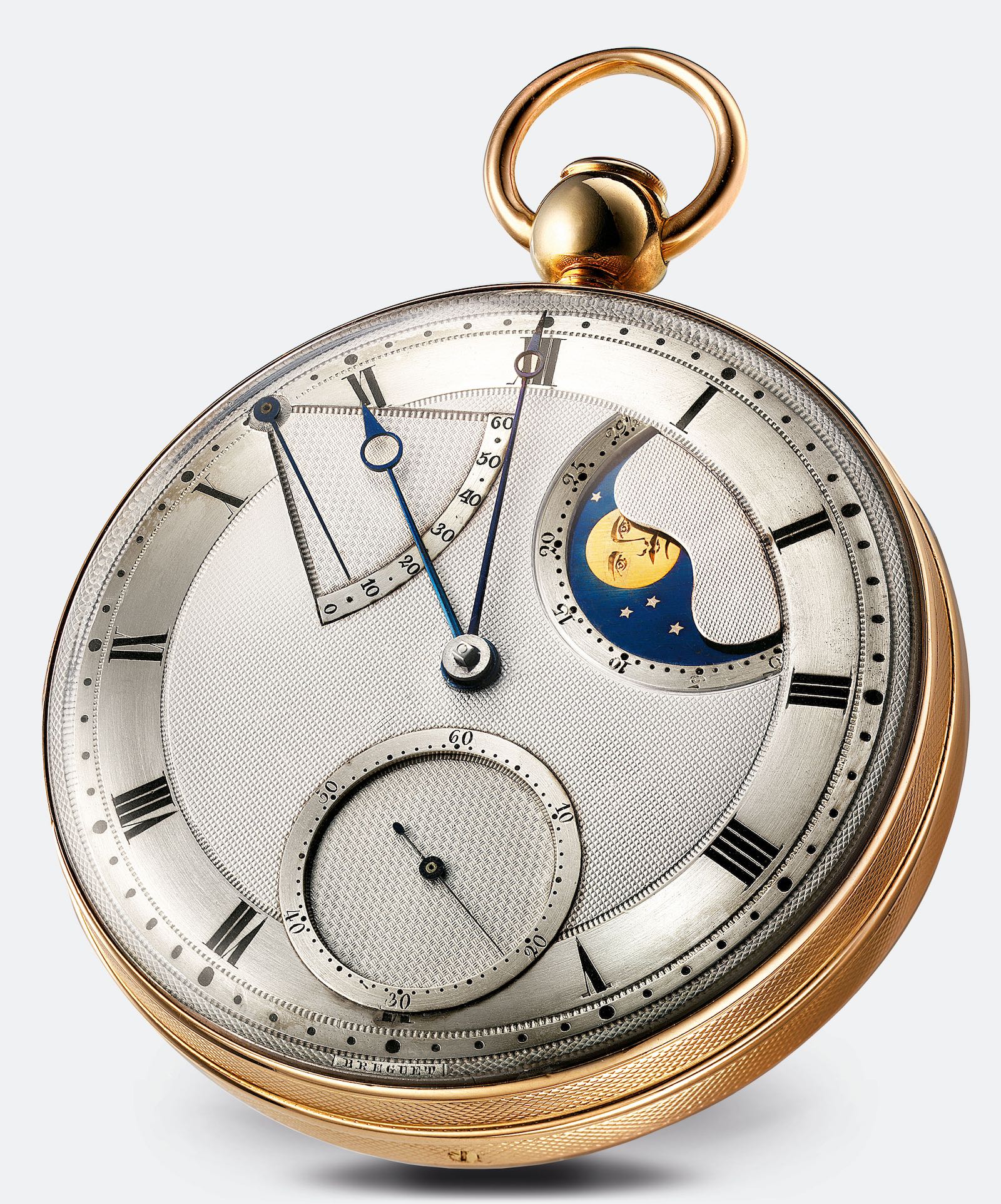
This elegant wristwatch, with its unusual, intentionally unbalanced display is inspired by one of Abraham-Louis Breguet oldest (and nicest) creations, the Breguet N°5. This 54mm diameter pocket watch was sold, according to the brand’s archives, to a certain Count Journiac Saint-Méard in 1794. Crafted in yellow gold and showing a superbly refined silver guilloché dial, it is one of the finest examples of Breguet’s work.
This perpétuelle pocket watch (meaning an automatic movement) features an “à toc” quarter repeater, a mechanism where a hammer strikes the time by “knocking” on the case, instead of striking on a gong (this will be later invented by Breguet). This watch features a temperature compensating balance, two barrels, a lever escapement and boasts 60h of power reserve.
Most importantly here, the display is typical of Breguet’s work – his idea was to increase legibility and functionality, even when adding complications. As such, there’s no void space on the dial and the complications are displayed in an unbalanced, yet superb way, with the age of the moon, the small seconds and the power reserve indicator all “answering” to the other complications.

Noteworthy, just like the Marie-Antoinette Grande Complication watch (which was stolen), Breguet faithfully recreated the N°5 pocket watch, with production that started in 2004 – and not just one unique piece to be displayed in the Museum (where the original N°5 is), but a small series to be sold at a price of USD 1,800,000.
The Breguet Classique 7787 Moonphase
Now, obviously, getting access to such a modern recreation of a Breguet pocket watch, or even more an antique Breguet pocket watch, is close to impossible – simply because of the availability and of the (ridiculously high) price. However, the modern side of Breguet – referring to the manufacture owned by the Swatch Group – has always been very good at bringing the antique feel of Abraham-Louis’ creations in inspired modern pieces to be worn on the wrist. The model we have today with us, one of the most classic iterations in the current collection, is a perfect example of Breguet’s spirit.
Everything in this Classique 7787 Moonphase, from the case to the dial or the display, transpires Breguet… In the best possible way.
While the Breguet Classique 7787 isn’t per se a 1-to-1 recreation of the N°5 pocket watch, as the position of the complications isn’t entirely faithful, this watch should be regarded as a watch “inspired by”. This model debuted in 2011 with a traditional silvered guilloché dial, in both pink and white gold, and in two sizes: 39mm for men, 36mm for women. More recently, the brand introduced this white Grand Feu enamel version, which is also available in pink or white gold.
Looking at the watch as a whole, there’s not a single doubt regarding its provenance. Everything here “shouts” Breguet and the name printed on the dial is almost superfluous. The case is shaped like all the watches in the Classique collection, with a thin bezel and straight lugs that are welded onto the case band, with screw-pins, rather than conventional sprung bars, to hold the strap between the horns. Even more famous are the case bands, which are decorated with fluting (named cannelures in French). The fluted pattern is cold-rolled into the case band then finished by hand on a mechanical workpiece-holder.
This specific version of the Breguet Classique 7787 is presented in white gold, a recommended option in my opinion when combined with enamel dials, to be consistent with the “cold” colour scheme of the rest of the watch and emphasize discretion. The case has a 39mm diameter and a height of 10.2mm – not ultra-thin but sleek enough to be worn under a sleeve. The watch is worn on an equally classic black alligator strap with an 18k white gold pin buckle.
Moving to the dial, the first comment concerns the display. While inspired by the Breguet N°5, the position of the complications has been changed. On the Classique 7787 Moonphase, the moon has been shifted to the 12 o’clock position and in lieu of a small seconds sub-dial, this watch features a central seconds hand. Finally, while the power reserve indication still relies on a long baton hand and an arched track, its position is now in the lower right-hand side of the dial – with the same objective as the Breguet N°5, to create the “balanced asymmetry” so dear to Abraham-Louis Breguet. All these indications are pointed by traditional blued steel hands.
Now there’s the material of the dial itself. While Breguet watches are more often associated with the guilloché technique applied on a sold gold blank, white Grand Feu enamel is just as precious. Back in the earliest days of his work, Abraham-Louis Breguet also offered enamel dials, again with the same simplification idea and focus on legibility as the guilloché dial – remember that, at the end of the 18th century, high-end pocket watches were often highly decorated and baroque.
The milky white surface of the enamel is punctuated with stylized Arabic numerals, so-called “Breguet numerals”, as he designed this font himself. There’s a great balance in this dial, besides the multiple tracks and markers (especially the 5-minute markers) and proper consistency in the use of fonts and colours. The overall result is undoubtedly Breguet, with this unique old-fashioned elegance and a style that is immediately recognizable, even without a guilloché dial. This watch has a great personality but never feels ostentatious.
Powering the Breguet Classique 7787 Moonphase is an automatic in-house movement, calibre 591 DRL. This modern engine features a central oscillating weight in gold with a guilloché pattern and is decorated in a discreet but pleasant way – Geneva stripes, polished bevels, golden engravings, black polished steel parts. This movement relies on the brand’s and Swatch Group’s innovative materials, such as a silicon escapement and hairspring (with anti-magnetic properties) or a free-sprung balance wheel with four timing screws.
This movement, which beats at 4Hz, delivers the Breguet Classique 7787 Moonphase a power reserve of 38 hours. If I had one complaint about this watch, it would be this short supply of energy… I know it is an automatic watch but a longer power reserve would be helpful when it comes to adjusting the complications – the moon indication is adjusted by a corrector in the case band.
Price and availability
The Breguet Classique 7787 Moonphase is available at all Breguet boutiques and retailers and is priced at EUR 29,500 in this white gold/enamel configuration (ref. 7787BB/29/9V6).
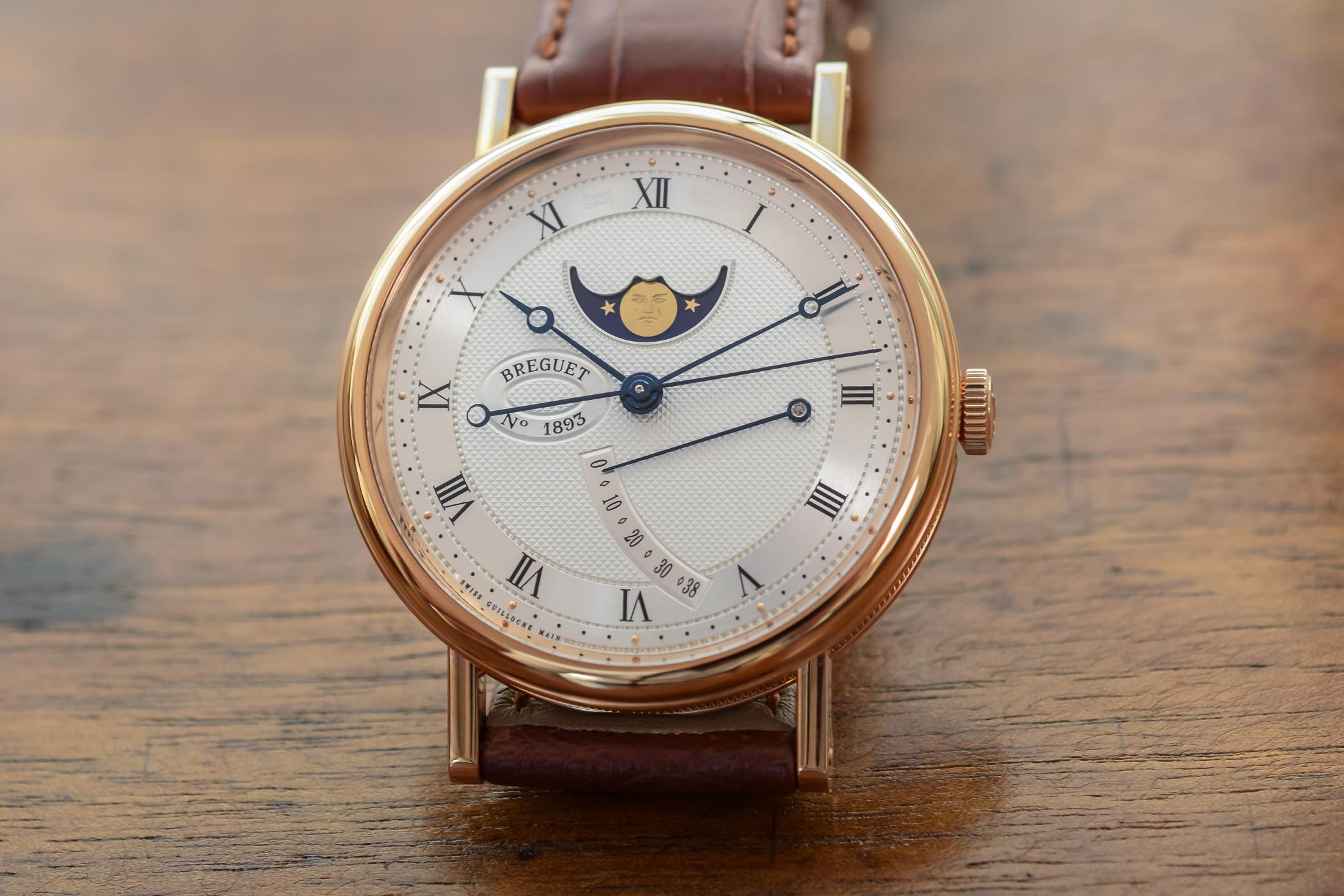
Note that it is also available in pink gold/enamel (7787BR/29/9V6), in white gold/guilloché (7787BB/12/9V6) and pink gold/guilloché (7787BR/12/9V6). More details at breguet.com.


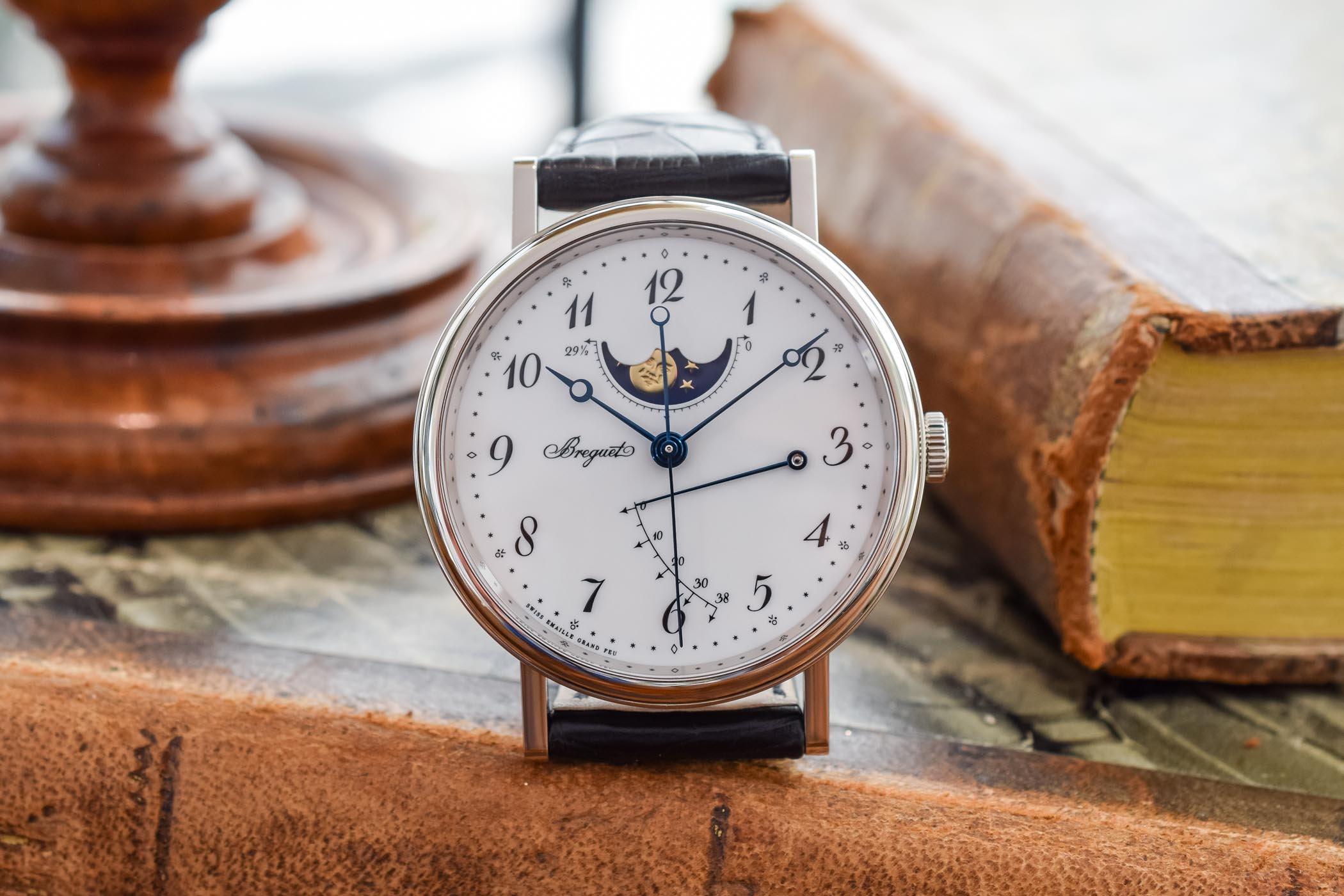

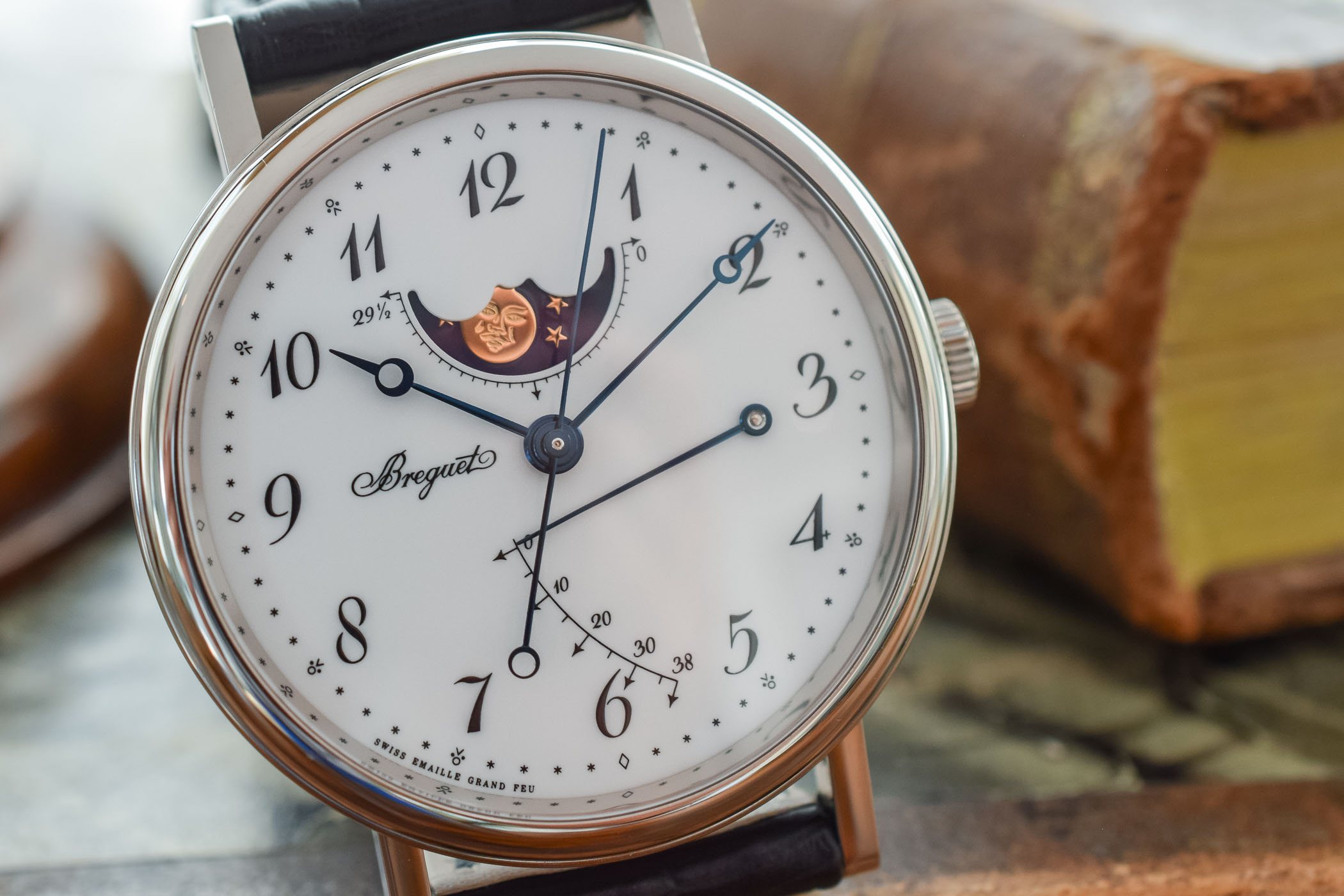
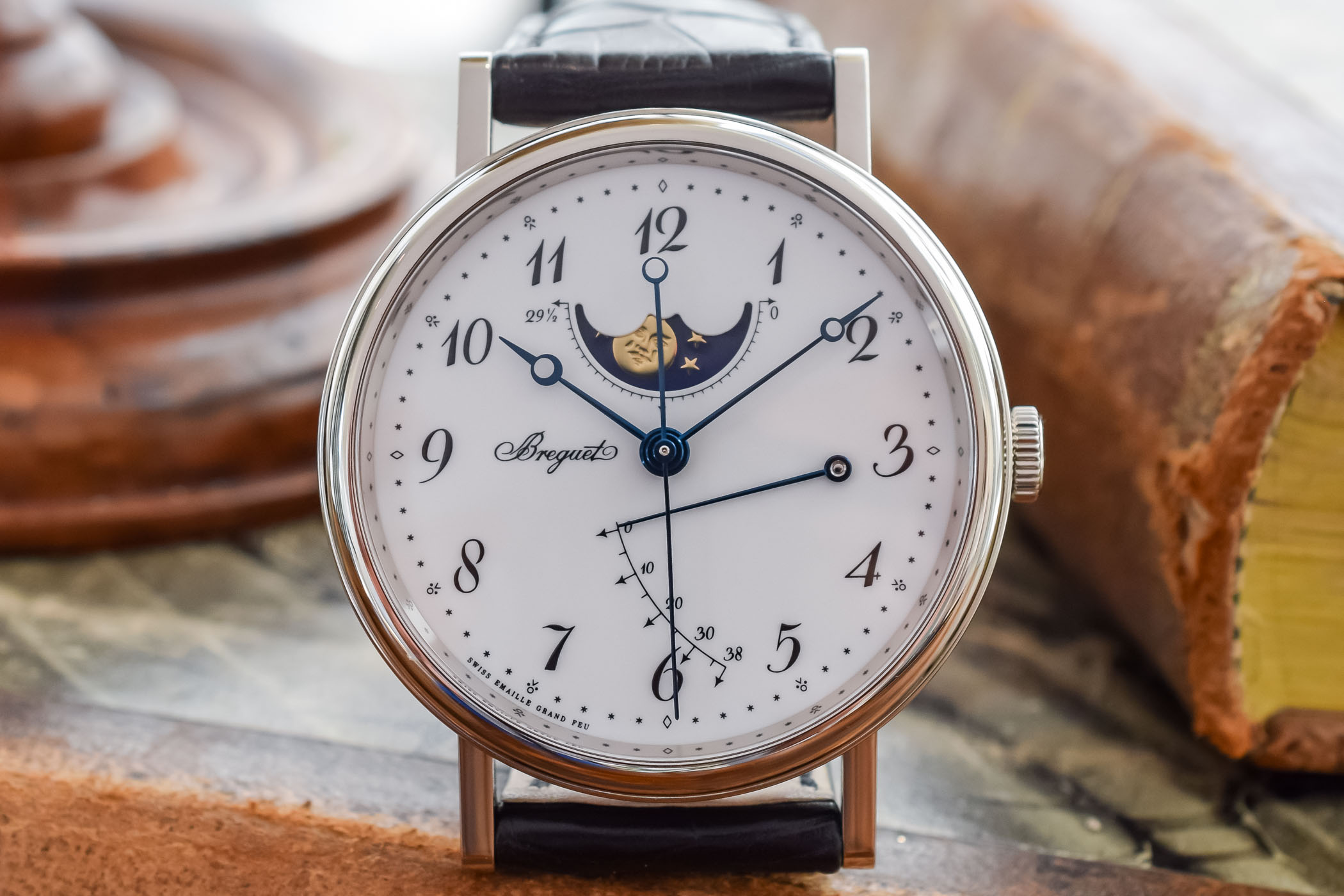

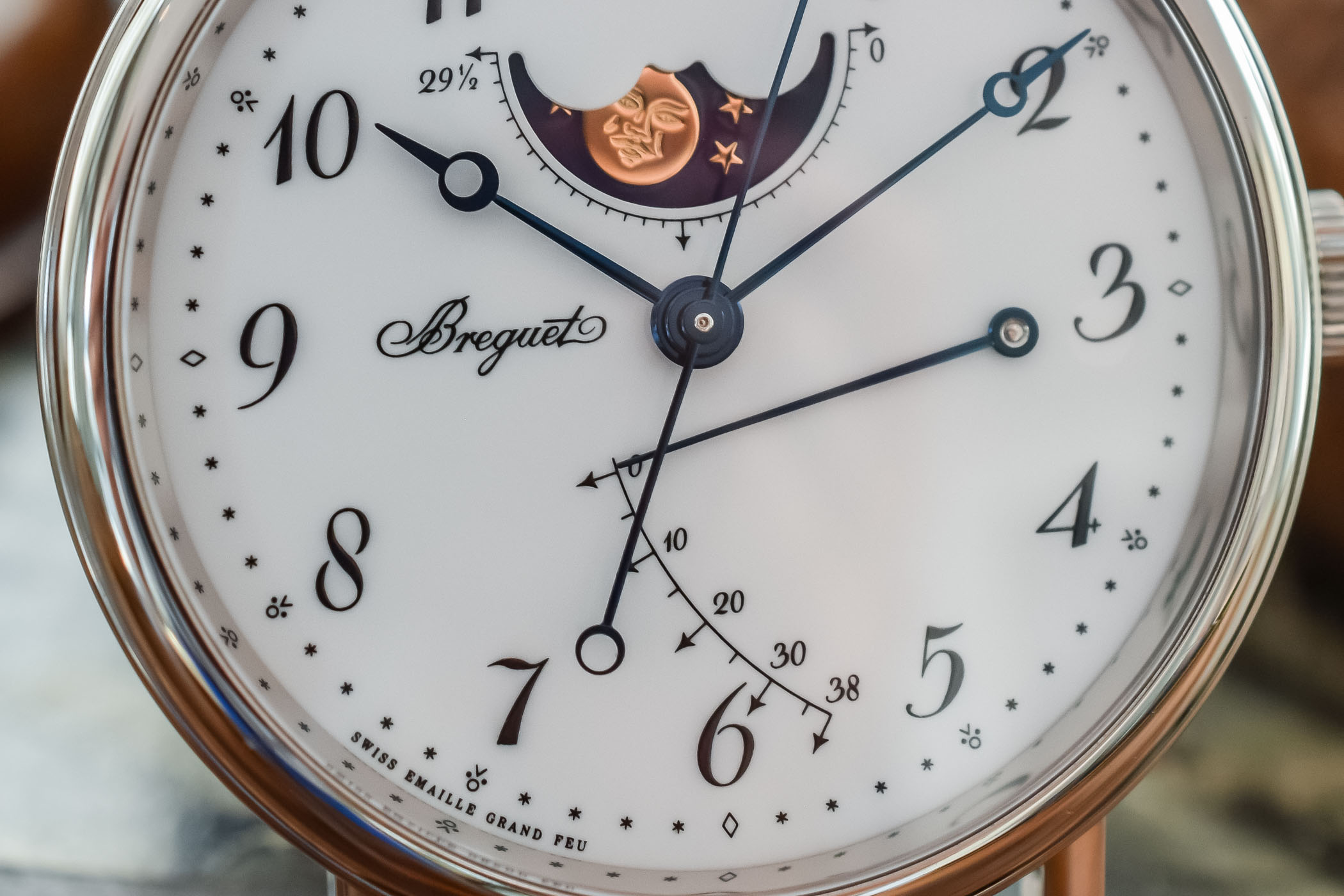

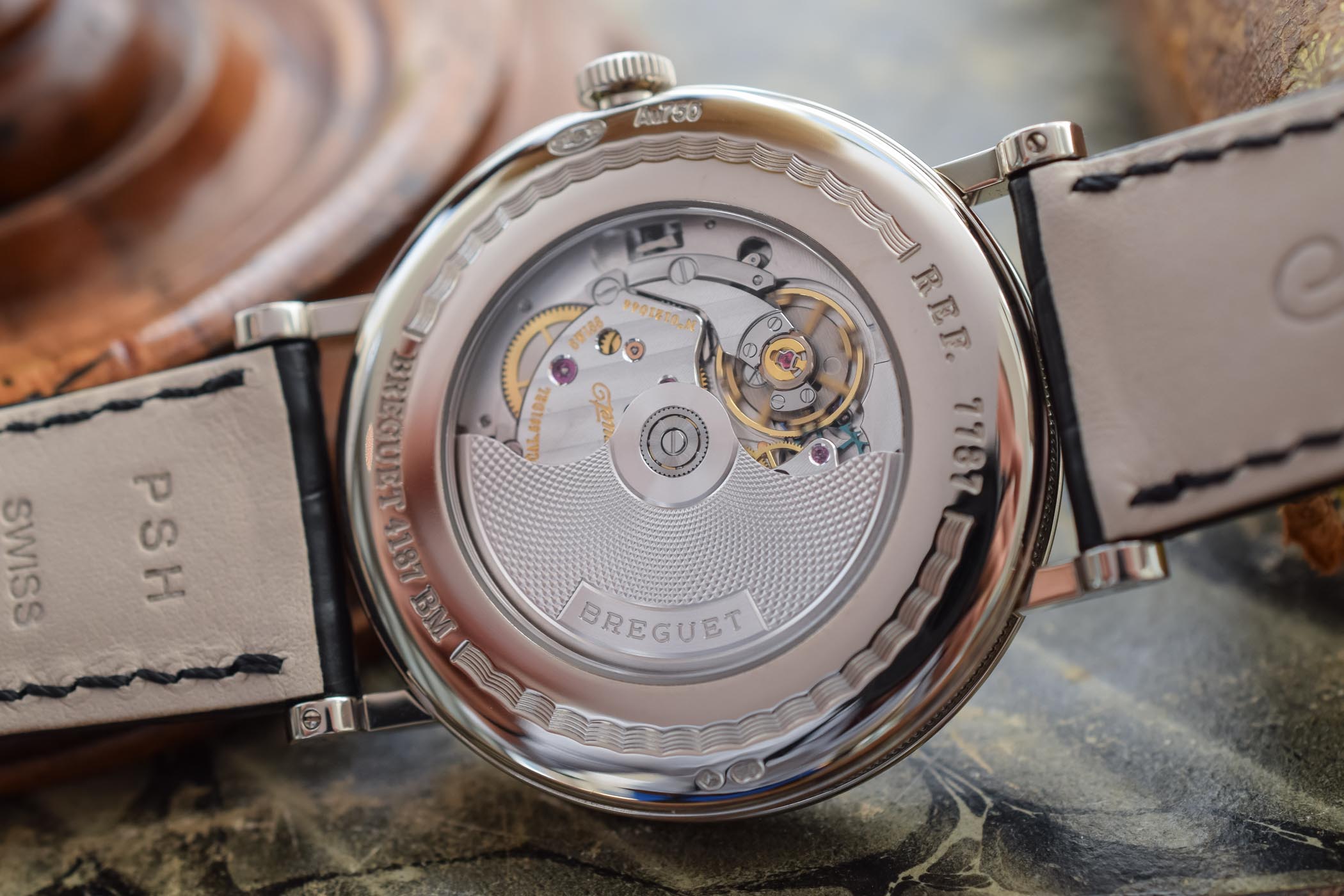

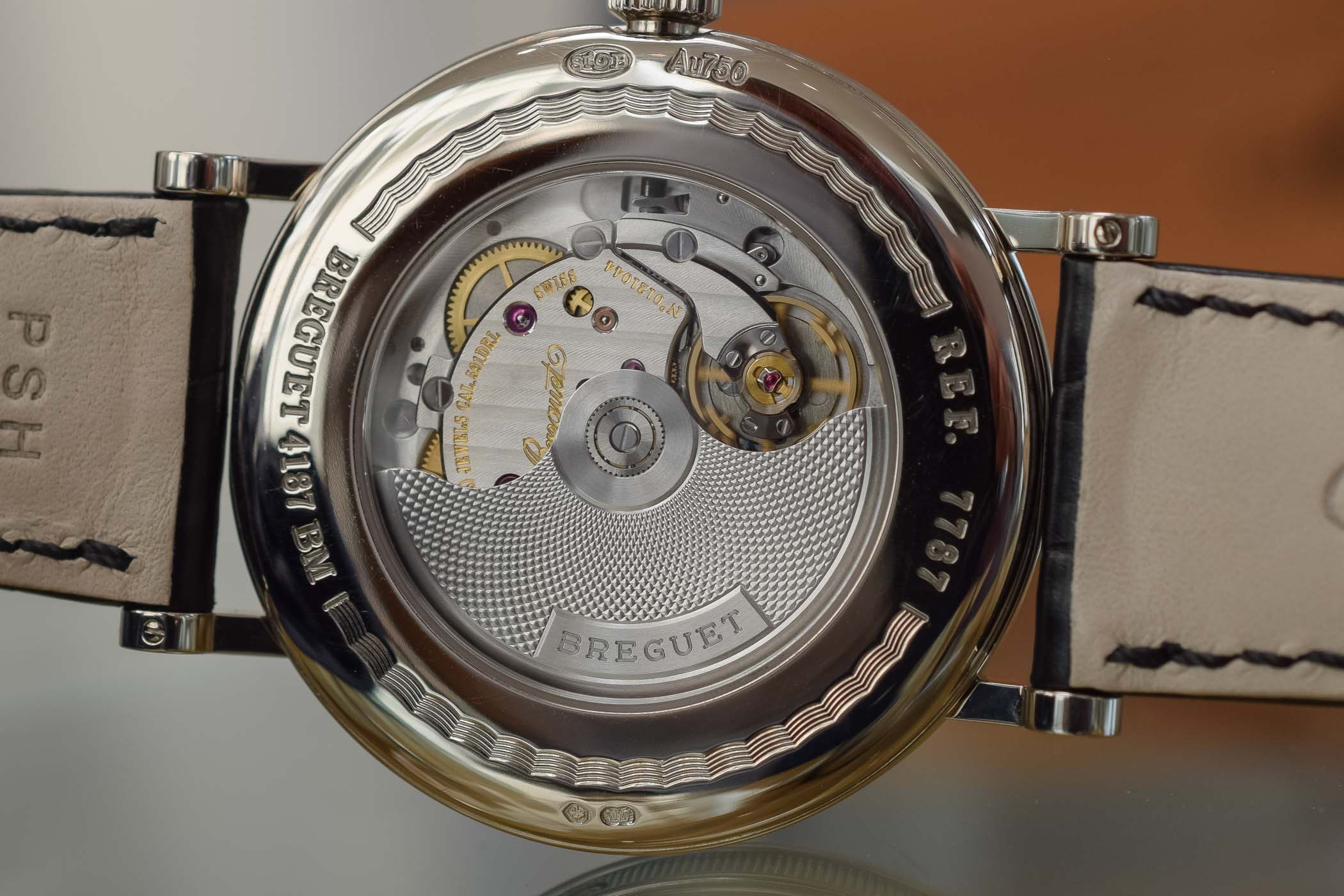



3 responses
That’s what I like about Breguet. Even though they’re not quite what they once were (although having a descendant of Abraham-Louis as a director is a much appreciated circumstance), they still have a rich and real history to uncynically link to. I love how my 5157 is essentially a modern incarnation of the 4270 pocketwatch from c1825.
Yes, Breguet really do epitomise elegance almost all of the time. For myself, the guilloche dial works better with this set-up. I prefer to see enamel uncluttered, in all its glory. But having said that, a moonphase and large, sweeping power reserve is too complicated. The 5157 is much more my style. The 5367 does asymmetry much better than this 7787.
The 5277 is where they hit the nail on the head for those looking for a slightly busier dial. It looks a little like a flipped image of a Roger Smith Series 2.